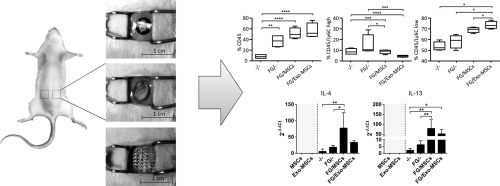Acta Biomaterialia ( IF 9.4 ) Pub Date : 2018-02-17 , DOI: 10.1016/j.actbio.2018.02.014 Rebeca Blázquez , Francisco Miguel Sánchez-Margallo , Verónica Álvarez , Alejandra Usón , Federica Marinaro , Javier G. Casado

|
Surgical meshes are effective and frequently used to reinforce soft tissues. Fibrin glue (FG) has been widely used for mesh fixation and is also considered an optimal vehicle for stem cell delivery. The aim of this preclinical study was to evaluate the therapeutic effect of MSCs and their exosomes combined with FG for the treatment of incisional hernia.
A murine incisional hernia model was used to implant surgical meshes and different treatments with FG, MSCs and exo-MSCs were applied. The implanted meshes were evaluated at day 7 by anatomopathology, cellular analysis of infiltrating leukocytes and gene expression analysis of TH1/TH2 cytokines, MMPs, TIMPs and collagens.
Our results demonstrated a significant increase of anti-inflammatory M2 macrophages and TH2 cytokines when MSCs or exo-MSCs were used. Moreover, the analysis of MMPs, TIMPs and collagen exerted significant differences in the extracellular matrix and in the remodeling process.
Our in vivo study suggests that the fixation of surgical meshes with FG and MSCs or exo-MSCs will have a beneficial effect for the treatment of incisional hernia in terms of improved outcomes of damaged tissue, and especially, in the modulation of inflammatory responses towards a less aggressive and pro-regenerative profile.
Statement of significance
The implantation of surgical meshes is the standard procedure to reinforce tissue defects such as hernias. However, an exacerbated and persistent inflammatory response secondary to this implantation is frequently observed, leading to a strong discomfort and chronic pain in the patients. In many cases, an additional surgical intervention is needed to remove the mesh.
This study shows that mesenchymal stem cells and their exosomes, combined with a fibrin sealant, can be used for the successful fixation of these meshes. This new therapeutic approach, assayed in a murine model of incisional hernia, favors the modulation of the inflammatory response towards a less aggressive and pro-regenerative profile.
中文翻译:

纤维蛋白胶网固定与间充质干细胞或外泌体结合可调节小鼠切口疝的炎症反应
外科手术网片是有效的并且经常用于增强软组织。纤维蛋白胶(FG)已被广泛用于网格固定,也被认为是干细胞递送的最佳载体。这项临床前研究的目的是评估MSC及其外泌体与FG联合治疗切口疝的疗效。
使用鼠切开疝模型植入外科手术网,并应用FG,MSC和exo-MSC进行不同的治疗。在第7天通过解剖病理学,浸润白细胞的细胞分析以及TH1 / TH2细胞因子,MMP,TIMP和胶原蛋白的基因表达分析来评估植入的网片。
我们的结果表明,使用MSC或exo-MSC时,抗炎M2巨噬细胞和TH2细胞因子显着增加。此外,MMP,TIMP和胶原蛋白的分析在细胞外基质和重塑过程中具有显着差异。
我们的体内研究表明,用FG和MSC或exo-MSC固定手术网片对切开疝具有有益的作用,可改善受损组织的预后,尤其是对炎症反应的调节。攻击性和促进再生能力较弱。
重要声明
手术网片的植入是强化组织缺损(例如疝气)的标准程序。然而,经常观察到继发于该植入的加剧和持续的炎性反应,导致患者强烈不适和慢性疼痛。在许多情况下,需要额外的外科手术来去除网孔。
这项研究表明,间充质干细胞及其外来体与纤维蛋白封闭剂结合可用于成功固定这些网孔。在切开疝的鼠模型中测定的这种新的治疗方法,有利于调节炎症反应,使其趋向侵略性和再生性较弱。











































 京公网安备 11010802027423号
京公网安备 11010802027423号